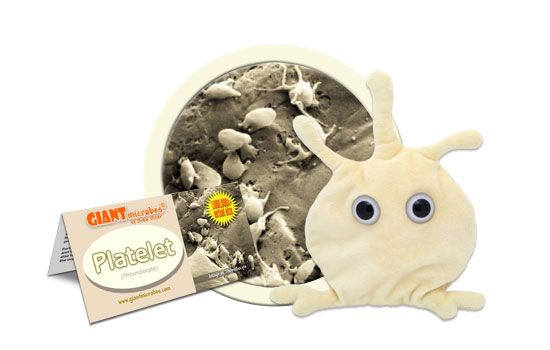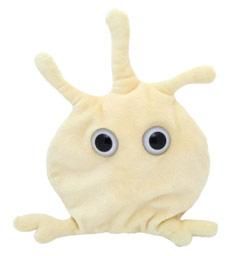Platelet (Thrombocyte)
Platelets are the smallest cells in the blood. Under the microscope, they look like tiny disks, or plates. Platelets main role is to prevent bleeding by creating blood clots.
Laughter is the best medicine: if you get a cut, Platelet will have you in stitches.
Product Details
Additional Information
| Sizes | Giantmicrobes are based on actual microbes, cells, organisms and other critters, only 1,000,000 times actual size! Gigantic (GG) 16-24" XL (XL) 10-15" Original (PD) 5-8" Keychain (KC) 2-4" with clip |
|---|---|
| Materials | Plush from all new materials. Stuffed with polyester fiber fill. Surface washable: sponge with water & soap, air dry. |
| Packaging | Each plush microbe includes a printed card with fun, educational and fascinating facts about the actual microbe or cell. |
| Safety | Every product meets or exceeds U.S. and European standards for safety. For ages 3 and up. |
All about Platelet (Thrombocyte)
FACTS: Platelets, or thrombocytes, are the smallest cells (or cell fragments) in the blood. Under the microscope, they normally look like little disks, or plates!
The primary purpose of platelets is to prevent bleeding by creating blood clots. As platelets circulate through the bloodstream, they normally slide along the smooth surface of the blood vessels without sticking. However, if the smooth wall is ruptured, platelets are activated: they swell up, stick to the exposed rough patch, and extend filaments which can help seal the breach.
The average person has between 150,000 to 400,000 platelets in every drop (or microliter) of blood. However, if platelet concentration falls to abnormally low levels (because platelet production in the bone marrow is insufficient, or because platelet absorption by the body is too rapid), the formation of blood clots can become impaired and bleeding can result. On the other hand, if platelet production is too rapid or absorption too slow, platelet levels can build into the millions per microliter, which can cause blood clots to form spontaneously, resulting in heart attacks and strokes. And even where platelet concentration is normal, platelets can become dysfunctional, because of hereditary conditions, disease, or the presence of platelet-altering substances such as aspirin in the body.
Fortunately, a variety of medical treatments can help restore platelet level and functionality. In addition, where necessary, platelet transfusions can also be performed – thanks to the many blood donors who keep stocking the cupboard.
| Description | Platelets help to bind together and create a blood clot to repair damaged blood vessels. When we get a cut platelets are there to stop the bleeding! |
|---|
| Name | Thrombocyte |
|---|
| Actual Size | Platelets are the smallest of the blood cells, and are 1.5 to 3 microns in diameter. |
|---|
| System | Platelets are made in the bone marrow and live in the circulatory system. |
|---|
| History |
Platelets were described in 1780 as very small undefined particles in blood. In 1842, Alfred Donne referred to platelets as a sort of small globular, pale, opaline corpuscles visible in blood. The first careful description of platelets was made by Max Schultze, who referred to platelets as “...clumps of irregular shape and different size… composed by small globules or colourless granules…These particles are often sharp-cornered or have a granular appearance....lack spontaneous motility... related to blood clotting....” |
|---|
| Fascinating Facts |
An average adult produces 100,000,000,000 platelets a day!
Snake venom contains toxins which target platelets, either activating them or preventing them from clotting. So a venomous snake bite could result either in excessive blood clotting, turning blood into a jelly-like matter, or profuse bleeding. |
|---|






